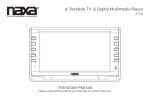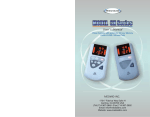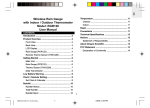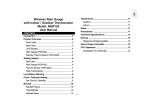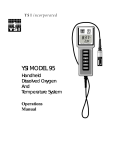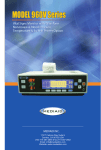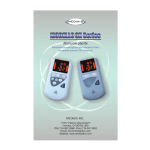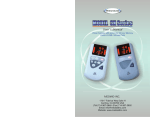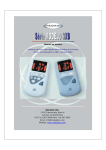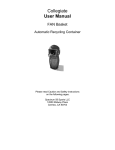Download Model 100 POX Manual - English: Low Resolution
Transcript
Model 100 Pulse Oximeter User’s Manual MEDIAID INC. 17517 Fabrica Way • Cerritos California 90703 USA Tel.: 714-367-2848 • Fax: 714-367-2852 Web: www.mediaidinc.com Email: [email protected] POX010-100 Contents Contents Chapter 1: Principles of Operation .......................................................... 1 Intended Uses ........................................................................................................ 1 Principles of Pulse Oximetry ................................................................................. 1 Intrinsic Calibration ................................................................................................ 1 Principal Features .................................................................................................. 2 Cautions ................................................................................................................. 2 Preventing Device Complications and Faulty Readings...................................... 3 Chapter 2: Features, Indicators, and Symbols ...................................... 5 Model 100 Front View............................................................................................ 5 Model 100 Back View ............................................................................................ 6 LED Display............................................................................................................ 6 Pulse Oximeter Top View ...................................................................................... 7 Integral Finger Sensor Front/Top View................................................................. 7 Cable Adapter Front/Top View .............................................................................. 8 Cable Adapter and Integral Finger Sensor Bottom View..................................... 8 Symbols.................................................................................................................. 9 Chapter 3: Operating the Model 100 ......................................................11 Replacing the Battery ..........................................................................................11 Attaching the Integral Finger Sensor or the Cable Adapter...............................12 Removing the Integral Finger Sensor .................................................................13 Removing the Cable Adapter ..............................................................................13 Removing the Belt Clip ........................................................................................14 Attaching the Belt Clip .........................................................................................14 Powering On the Model 100................................................................................14 Powering Off the Model 100................................................................................15 Measuring Oxygen Saturation and Pulse Rate ..................................................15 Chapter 4: Maintaining the Model 100 ...................................................17 Cleaning the Model 100.......................................................................................17 Troubleshooting ...................................................................................................17 Chapter 5: Equipment Specifications....................................................19 General Specifications.........................................................................................19 Environmental Conditions....................................................................................20 Equipment Classification .....................................................................................21 - Contents 1 - Contents Chapter 6: Mediaid Inc. Limited Warranty ............................................23 Applicability of Warranty ......................................................................................23 Warranty Coverage..............................................................................................23 Mediaid Problem Correction Plan .......................................................................24 Owner’s Registration ...........................................................................................24 Chapter 7: User References ....................................................................25 Contact/Customer Service Information...............................................................25 Product Information..............................................................................................26 - Contents 2 - Principles of Operation Chapter 1: Principles of Operation Intended Uses WARNING The Mediaid Model 100 pulse oximeter is intended to nonBefore using the Model 100, invasively measure arterial oxygen become thoroughly familiar saturation and pulse rate in with the information in this hospitals, physicians’ offices, manual. emergency medical facilities, or at home. The Model 100 is not intended for continuous patient monitoring. Principles of Pulse Oximetry The Mediaid Model 100 pulse oximeter is designed to measure the percentage of functional oxygenated hemoglobin to total hemoglobin. Non-invasive arterial oxygen saturation measurement is obtained by directing red and infrared light through a pulsating vascular bed. The pulsating arterioles in the path of the light beam cause a change in the amount of light detected by a photodiode. The pulse oximeter determines the oxygen saturation of arterial blood by measuring the ratio of transmitted red to infrared light within the pulse waveform. The nonpulsatile signal is removed electronically for the purpose of calculation. Therefore, skin, bone, and other non-pulsating substances do not interfere with the measurement of arterial oxygen saturation. Intrinsic Calibration The light absorption by hemoglobin is wavelength-dependent. Mediaid red and infrared LED wavelengths are tightly controlled by testing in production. In addition, the LED intensity recorded at the detector is automatically adjusted for amplitude; this allows Mediaid pulse oximetry sensors to be used interchangeably without calibration. -1- Principles of Operation Principle Features The Mediaid Model 100 pulse WARNING oximeter is a portable, lightweight, Do not use the Model 100 for pocket-sized instrument that continuous patient monitoring. monitors functional arterial oxygen saturation and pulse rate non-invasively. The principal features of the Model 100 are as follows: • • • • Gives an alternating readout of SpO2 percentage (%SpO2) and pulse rate in beats per minute (BPM) on a 3-digit, 7-segment LED (lightemitting diode) display. Can be used with either the Integral Finger Sensor or any Mediaid pulse oximetry sensor that has a CompuShield® Connector that attaches to the Cable Adapter. Increases the longevity and functionality of the pulse oximeter with the removable and replaceable sensor modules. Performs approximately 1200 spot checks on a single 1.5 volt, AAsized alkaline battery (when using a Duracell® Ultra battery, which is recommended). Cautions General Cautions • • • • • US federal law restricts this device to sale by or on the order of a physician. Become thoroughly familiar with the information in this User’s Manual and all accompanying documents before using the Model 100. Do not attempt to modify or repair the instrument—doing so voids the warranty. Dispose of this device according to governmental regulations. Adhere to all cautions, stipulations, and instructions included with the Integral Finger Sensor, the Cable Adapter., and all Mediaid sensors used with the Cable Adapter.. Environmental Cautions • • • Do not use the instrument in the presence of flammable agents or flammable anesthetics. Do not immerse in liquid and do not allow any liquid to penetrate the instrument’s interior. Operate the pulse oximeter in normal light conditions. -2- Principles of Operation • • • • Avoid bright light or glare on the sensing area to ensure correct reading of the displays and indicators. Keep the pulse oximeter away from MRI (Magnetic Resonance Imaging) equipment. Move the pulse oximeter away from other electromagnetic-emitting equipment if you experience interference problems. This device complies with electromagnetic compatibility standard EN 60601-1-2. Keep away from equipment that emits x-ray alpha particles, beta particles, neutron particles, or microwave emissions. Battery Cautions • • • • Use only 1.5 volt, AA-sized alkaline batteries (Duracell Ultra batteries are recommended). Never use manganese batteries, lithium batteries, or any other type of battery not specifically recommended. Use of such batteries may damage the pulse oximeter. Never dispose of batteries into fire, short-circuit the terminals, or attempt to disassemble, heat, or recharge the batteries. Doing so may damage the batteries and cause a fire, injury, or environmental contamination. Liquid leaking from the battery can cause skin burns or damage the pulse oximeter. If a battery leaks inside the instrument, return the pulse oximeter for servicing. Remove the battery during shipment or if the Model 100 is to be idle for several weeks. Preventing Device Complications and Faulty Readings To prevent device complications or faulty readings: • Trim the patient’s long fingernails and remove artificial nails and thick nail polish. • Insert the patient’s finger completely into the Integral Finger Sensor. • When using the Integral Finger Sensor, both the pulse oximeter and the patient’s hand should rest on the same flat surface. • Fit the sensor comfortably without constricting or compressing the application site when using a sensor that is attached to the Cable Adapter. • Do not apply the sensor to anything but a well-perfused extremity. • Do not apply the sensor on extremities that have blood pressure cuffs or arterial or venous catheters. -3- Principles of Operation • • • • • • • • • Avoid extremity positions that could compromise venous return. Keep sensors at heart level whenever possible. Check for intravascular dyes, which may affect pulse oximeter readings. Turn off very bright lights, such as surgical, bilirubin, fluorescent, or infrared heating if they interfere with sensor functioning. In cases where such lights are unavoidable, cover the sensor site with an opaque material. Route sensor cords carefully. Avoid applying excessive tension to the sensor or sensor cable. Consider conditions affecting the hemoglobin dissociation curve when interpreting pulse oximeter readings (such as intravascular dyes). Keep patient movement to a minimum. When not in use, do not wind the sensor cord around the oximeter. -4- Features, Indicators, and Symbols Chapter 2: Features, Indicators, and Symbols Model 100 Front View A. Module Release The Module Release mechanism allows for removal of the Integral Finger Sensor or the Cable Adapter module from the Model 100. B. Module Connector The Module Connector connects the Integral Finger Sensor or the Cable Adapter module to the Model 100. C. LED Display The LED Display alternates between showing the pulse rate and the oxygen saturation values. The LED Display also shows error code numbers and functions. D. Visual Pulse Indicator The Visual Pulse Indicator is an orange LED that flashes with every pulse detected by the Model 100. -5- Features, Indicators, and Symbols Model 100 Back View A. Module Release The Module Release mechanism allows for removal of either the Integral Finger Sensor or the Cable Adapter module from the Model 100. B. Battery Compartment The Battery Compartment holds a single 1.5 volt, AA-sized alkaline battery that provides operating power for the Model 100. C. Belt Clip The removable Belt Clip provides a convenient method of carrying the Model 100. D. Belt Clip Retaining Screw The Belt Clip Retaining Screw attaches the Belt Clip to the Model 100. LED Display A. Oxygen Saturation Display The Oxygen Saturation Display shows the oxygen saturation values. B. Oxygen Saturation Indicator The Oxygen Saturation Indicator lights whenever an oxygen saturation value is displayed. C. Low Battery Indicator The Low Battery Indicator lights up whenever the remaining operation time is less than 30 minutes. D. Pulse Rate Display The Pulse Rate Display shows the pulse rate values. E. Pulse Rate Indicator The Pulse Rate Indicator lights up when a pulse rate value is displayed. -6- Features, Indicators, and Symbols Pulse Oximeter Top View A. Module Connector The Module Connector connects the Integral Finger Sensor or the Cable Adapter module to the pulse oximeter. B. Insertion Guides The Insertion Guides align with the Insertion Tabs on the Integral Finger Sensor or the Cable Adapter to ensure proper attachment. Integral Finger Sensor Front/Top View A. Sensor Top Lever The Sensor Top Lever is pressed to open the sensor so that a finger can be inserted. Pressing the Sensor Top Lever when the Integral Finger Sensor is attached powers on the Model 100. B. Finger Insertion Area The Finger Insertion Area is the location for insertion of a finger or a thumb into the sensor. C. Insertion Tabs The Insertion Tabs align with the Insertion Guides on the pulse oximeter to ensure proper attachment. -7- Features, Indicators, and Symbols Cable Adapter Front/Top View A. Cable Adapter On/Off Key The Cable Adapter On/Off key powers on the pulse oximeter when the Cable Adapter is attached. B. CompuShield Connector The CompuShield Connector connects an appropriate Mediaid sensor to the Cable Adapter. C. Insertion Tabs The Insertion Tabs align with the Insertion Guides on the pulse oximeter to ensure proper attachment. Cable Adapter and Integral Finger Sensor Bottom View A. Spring Clip The Spring Clip secures either the Integral Finger Sensor or the Cable Adapter to the pulse oximeter. B. Module Release The Module Release mechanism allows for removal of either the Integral Finger Sensor or the Cable Adapter from the pulse oximeter. C. Insertion Tabs The Insertion Tabs align with the Insertion Guides on the pulse oximeter to ensure proper attachment. D. Rear Connector The Rear Connector electrically connects Integral Finger Sensor or the Cable Adapter to the pulse oximeter. -8- Features, Indicators, and Symbols Symbols Symbols Definition Cable Adapter On/Off SpO2 Oxygen Saturation BPM Pulse Rate Indicator Low Battery Indicator Battery Polarity Symbol Attention: Consult accompanying documents Not anesthetic proof Type BF equipment Date of manufacture RX Only US federal law restricts this device to sale by or on the order of a physician -9- Principe d’Utilisation - 10 - Operating the Model 100 Chapter 3: Operating the Model 100 Replacing the Battery The Model 100 is powered by a CAUTION single 1.5 volt, AA-sized Always adhere to all of the alkaline battery that will operate cautions listed in “Battery the instrument for Cautions,” in Chapter 1. approximately 1200 spot checks (when using a Duracell Ultra battery). To replace the battery, complete the following steps. 1. Gently press down on the Battery Compartment door and push it out of the pulse oximeter. 2. Insert the battery. Follow the correct polarity indicated by the Battery Polarity symbol located on the inside of the compartment. 3. Insert the tabs on the Battery Compartment Door into the Battery Compartment and gently slide the door into place. - 11 - Operating the Model 100 Attaching the Integral Finger Sensor or the Cable Adapter To attach either the Integral Finger Sensor or the Cable Adapter to the Model 100, complete the following steps. CAUTION To obtain accurate oximetry readings, choose an appropriate Mediaid pulse oximeter and sensor according to the intended use. Follow all instructions stated within this manual as well as those included with each sensor. FIGURE 1 NOTE The Integral Finger Sensor or the Cable Adapter can be left connected to the pulse oximeter. FIGURE 2 1. Set the Integral Finger Sensor or the Cable Adapter module into the pulse oximeter, pointing the Rear Connector of the module toward the Module Connector of the pulse oximeter (Figure 1). The arrow on the bottom of the module will point toward the LED Display of the pulse oximeter. 2. Slide the Integral Finger Sensor or the Cable Adapter module completely into the pulse oximeter (Figure 2). The Insertion Tabs at the end of the module will fit into the Insertion Guides on the pulse oximeter. - 12 - Operating the Model 100 Removing the Integral Finger Sensor To remove the Integral Finger Sensor from the Model 100, complete the following steps. 1. Locate the Module Release mechanism at the back of the instrument (just above the label). 2. Push the pointed end of a paper clip into the Module Release mechanism, while simultaneously pushing gently upward on the Sensor Top Lever (Figure 3), until the Integral Finger Sensor is released. Slide the Integral Finger Sensor out of the pulse oximeter. FIGURE 3 Removing the Cable Adapter To remove the Cable Adapter from the pulse oximeter, complete the following steps. 1. Locate the Module Release mechanism at the back of the pulse oximeter (just above the label). 2. Push the pointed end of a paper clip into the Module Release mechanism, while simultaneously pushing upward on the Cable Adapter or pulling upward on the attached sensor connector (Figure 4). Slide the Cable Adapter out of the pulse oximeter. FIGURE 4 - 13 - Operating the Model 100 Removing the Belt Clip To remove the Belt Clip from the Model 100, complete the following steps. 1. Use a #1 Jeweler’s (small Phillips) screwdriver to remove the Belt Clip Retaining Screw. 2. Remove the Belt Clip from the pulse oximeter. Attaching the Belt Clip If the Belt Clip has been removed from the pulse oximeter, complete the following steps to replace it. 1. Place the flat part of the Belt Clip on the back of the pulse oximeter, lining up the screw holes on the Belt Clip and the pulse oximeter. 2. Place the Belt Clip Retaining Screw into the hole in the Belt Clip. 3. Use a #1 Jeweler’s (small Phillips) screwdriver to tighten the Belt Clip Retaining Screw. Powering On the Model 100 To power on the Model 100, complete one of the following two steps. • WARNING To ensure personal safety and proper operation of the pulse oximeter, adhere to all directions, warnings, cautions, and policies stated within this manual as well as those included with each accessory. If the Integral Finger Sensor is attached, press the Sensor Top Lever until the Model 100 powers on. • If the Cable Adapter is attached, press the Cable Adapter On/Off key. After power-on, the pulse oximeter tests the sensor availability, internal functions, and the battery. The LED Display shows three dashes (- - -) during the power-on tests, which last 1-2 seconds. - 14 - Operating the Model 100 When the pulse oximeter has successfully passed the power-on tests, it begins measuring oxygen saturation and pulse rate data. If the battery is low, the Low Battery Indicator will light. An error code will show if any other malfunction occurs. See “Troubleshooting,” in Chapter 4, for error code interpretation. Powering Off the Model 100 To power off the pulse oximeter, WARNING complete one of the following To ensure personal safety and steps. proper operation of the pulse • If the Integral Finger Sensor is oximeter, adhere to all attached, remove the finger directions, warnings, cautions, from the sensor. and policies stated within this • If the Cable Adapter is manual as well as those attached, either press the included with each accessory. On/Off key or disconnect the sensor from the Cable Adapter. If the pulse oximeter cannot detect oxygen saturation or pulse rate, or if the finger is positioned incorrectly, it will power off automatically. Measuring Oxygen Saturation and Pulse Rate The Model 100 displays pulse oximetry data whenever a sensor is attached to a patient and the monitoring site has sufficient perfusion. Pulse oximetry data can be viewed on the LED Display, as follows: • Oxygen saturation values display for 7.5 seconds. • Pulse rate values display for 2.5 seconds. To measure pulse oximetry data, complete the following steps. 1. Apply the sensor to the patient. Either insert the patient’s finger into the Integral Finger Sensor, or apply the sensor that is attached to the Cable Adapter. 2. If the Cable Adapter is attached, press the Cable Adapter On/Off key to power on the Model 100. The LED Display shows three dashes (- - -) for 1-2 seconds while the Model 100 performs the power-on tests. The Pulse Indicator begins to blink, signalling that the Model 100 is measuring a site with sufficient perfusion. 3. If the Pulse Indicator does not blink, adjust the sensor position. - 15 - Operating the Model 100 After the power-on tests, the following information shows on the Model 100: • With each pulse detected by the pulse oximeter, the Vistual Pulse Indicator flashes. • SpO2 values show on the LED Display when the Oxygen Saturation Indicator lights. • Pulse rate values show on the LED Display when the Pulse Rate Indicator lights. The following conditions apply when the Model 100 cannot detect pulse rate or oxygen saturation values: • If the Model 100 cannot detect a pulse rate (but can detect oxygen saturation values), three dashes (- - -) will show on the LED Display each time the Pulse Rate Indicator lights. • If the Model 100 cannot detect oxygen saturation values (but can detect a pulse rate), three dashes (- - -) will show on the LED Display each time the Oxygen Saturation Indicator lights. • If the Model 100 can detect neither a pulse rate nor oxygen saturation values, it will power off automatically. - 16 - Maintaining the Model 100 Chapter 4: Maintaining the Model 100 Cleaning the Model 100 CAUTION The Mediaid Model 100 Pulse There are no user-serviceable Oximeter, the Integral Finger parts or adjustments inside the Sensor, and the Cable Adapter Model 100. Do not attempt to can be wiped clean with a soft open the instrument case—any cloth lightly dampened with attempt to open the instrument isopropyl alcohol, a glutaraldehyde voids the Mediaid warranty. solution, or soap and water. Do not Refer to the information in immerse in liquid or allow any “Mediaid Problem Correction liquid to penetrate the interior of Plan,” in Chapter 6, for service the pulse oximeter. Avoid caustic information. or abrasive cleaners that will mar the case or the sensors. Use extra care in cleaning the LED Display window to avoid scratching the finish. Troubleshooting Whenever an error occurs, the pulse oximeter displays the letters “Err” (error) for 2 seconds, and then displays the error code for 2 seconds. Error messages cycle three times, then the pulse oximeter powers off. Table 1 explains the error code messages and gives possible solutions to the problems described in the messages. - 17 - Maintaining the Model 100 Table 1 Error Code Description 2 The pulse oximeter will not power off 3 The battery needs to be replaced. 7,8 The Cable Adapter, the sensor attached to the Cable Adapter, or the Integral Finger Sensor is malfunctioning. 11 The pulse oximeter cannot detect the sensor, either because of a sensor malfuntion or the sensor is not properly attached. 4,6,9,10,12,13,14,15 An internal failure has occurred. Solution Remove the battery and contact Mediaid Inc. Technical Support. Replace the battery. If replacing it does not clear the code, contact Mediaid Inc. Technical Support. Replace the Integral Finger Sensor or the sensor attached to The Cable Adapter with a functioning sensor. If replacing the sensor does not clear the code, try replacing the Cable Adapter. If the error code persists, contact Mediaid Inc. Technical Support. Remove, then reattach the Cable Adapter and the sensor connected to the Cable Adapter, or the Integral Finger Sensor. If reattaching does not clear the error code, contact Mediaid Inc. Technical Support. Contact Mediaid Inc. Technical Support. If any other error codes appear, contact Mediaid Technical Support. - 18 - Equipment Specification Chapter 5: Equipment Specifications General Specifications Dimensions Size: 4.73 x 1.82 x 0.96 in 12 x 4.67 x 2.46 cm Weight: 4.1 oz/113 g w/Cable Adapter 3.9 oz/111 g w/Integral Finger Sensor (weight includes battery) Display Type: Display Rate SpO2: Every 7.5 seconds BPM: Resolution 3-digit, 7-segment LED display Every 2.5 seconds SpO2: 1% Pulse: 1 BPM Range SpO2: 20 to 100% Pulse: 25 to 250 BPM Accuracy SpO2: 100 to 70% ± 2% 69 to 60% ± 3% < 60% unspecified Pulse: 25 to 200 BPM ± 2 BPM, or 2% > 200 BPM ± 3% Response Time SpO2: 8 seconds for 80% of patients Pulse: 8 seconds for 80% of patients - 19 - Equipment Specification Sensors The Integral Finger Sensor, or any Mediaid pulse oximeter sensor with the CompuShield Connector for use with the Cable Adapter, is compatible with the Model 100. Red LED IR LED Wavelength: 660 ± 2 nm Energy: 60 uW Wavelength: 910 ± 10 nm Energy: 150 uW Power Source Battery Type: One 1.5 volt, AA-sized alkaline battery (Duracell Ultra recommended) Battery Life: Approximately 1200 Spot Checks (using Duracell Ultra) NOTE: Battery life varies with usage conditions and battery brand. Environmental Conditions Operating Temperature 0° to 40° C 32° to 104° F Storage/Transport Temperature -40° to 70° C -40° to 158° F Operational Relative Humidity 30 to 75% Storage/Transport Relative Humidity 10 to 100% (including condensation) - 20 - Equipment Specification Operational Atmospheric Pressure 700 to 1060 hPa Storage/Transport Atmospheric Pressure 500 to 1060 hPa Equipment Classification The Mediaid Model 100 Pulse Oximeter is classified according to CAN/CSA C22.2, No. 601-1, IEC 601-1, Part 1, Section 1, Subclause 5, as follows: • Type of protection against electric shock: Internally powered, Type BF applied parts. • Degree of protection against harmful ingress of water: Ordinary equipment. • Degree of safety of application in the presence of a flammable anesthetic mixture with air, or with oxygen or nitrous oxide: This equipment is not suitable for use in the presence of a flammable anesthetic mixture with air, or with oxygen or nitrous oxide. - 21 - Principe d’Utilisation - 22 - Mediaid Inc. Limited Warranty Chapter 6: Mediaid Inc. Limited Warranty Applicability of Warranty This warranty covers only the NOTE Mediaid Model 100 pulse oximeter This product is sold by Mediaid and accessories as indicated. It is Inc. (referred to as Mediaid) not extended to other products or under the warranties set forth components that the customer herein. uses in conjunction with Mediaid products. This warranty shall not apply if the manufacturer determines that the product has been damaged due to abuse, misuse, misapplication, accident, negligence, tampering, or as a result of service or modification by anyone other than an authorized Mediaid service technician. Opening of the sealed enclosure or altering of the serial number voids the Mediaid Warranty. Use of equipment contrary to or inconsistent with the User’s Manual will also void the warranty. Warranty Coverage Mediaid warrants that the Model 100 enclosed with this warranty will conform to the manufacturer’s specifications and shall be free from defects in workmanship and materials for a period of two years from the date of purchase. Batteries and accessories are excluded from this warranty. The Integral Finger Sensor and the Cable Adapter are warranted according to information on their respective instruction sheets. This warranty does not cover any damage done to the equipment during shipping, which shall be the sole responsibility of the transportation company. There are no warranties, expressed or implied, which extend beyond the warranties set forth herein. Mediaid makes no warranty of merchantability or fitness for a particular purpose with respect to the product or parts thereof. This warranty gives you specific legal rights. You may have other legal rights which vary from state to state (or - 23 - Mediaid Inc. Limited Warranty country to country). Mediaid will not be liable to the user for incidental or consequential damage or loss arising out of the user’s inability to use this product. Mediaid Problem Correction Plan Should the Mediaid product prove to be defective, contact Mediaid by telephone at: 1.714.367.2848 [email protected] Have the product and serial numbers available when calling. Mediaid will then issue a Return Authorization Number (RAN). Return the instrument securely packaged in its original shipping carton (or equivalent packaging), and include the RAN. Mediaid will repair any faulty workmanship and will either repair or replace (at our option) any defective part with new or refurbished parts. For non-warranty repairs, the customer will be charged the current repair rate at the time of receipt by Mediaid. All transportation charges shall be the customer’s responsibility. Always read the user’s manual carefully. The information included in the User’s Manual will assist the user in preventing equipment misuse and ensuring patient safety. Operation of the equipment in a manner contrary to or inconsistent with the User’s Manual voids the warranty. Owner’s Registration To assist Mediaid in better serving the user, please complete the included Warranty Registration Card and return it to: Mediaid Inc 17517 Fabrica Way, Suite H Cerritos, CA 90703 USA - 24 - User Information Chapter 7: User Information Contact/Customer Service Information For information on other Mediaid Inc. products, visit the Mediaid Inc. home page on the web at www.mediaidinc.com, or contact us at: Customer Service 17517 Fabrica Way, Suite H Cerritos, CA 90703 USA Returns Department 17517 Fabrica Way, Suite H Cerritos, CA 90703 USA Phone 714.367.2848 Fax 714.367.2852 Email [email protected] - 25 - User Information Product Information To better assist customers, Mediaid recommends that all users write down all pertinent product and warranty information in the spaces provided below: Model 100 Product Number: POX010-100 Serial Number: Warranty Expiration Date: Integral Finger Sensor Product Number: POX050-750-1S Serial Number: Warranty Expiration Date: Cable Adapter Product Number: POX055-200-1S Serial Number: Warranty Expiration Date: - 26 -































